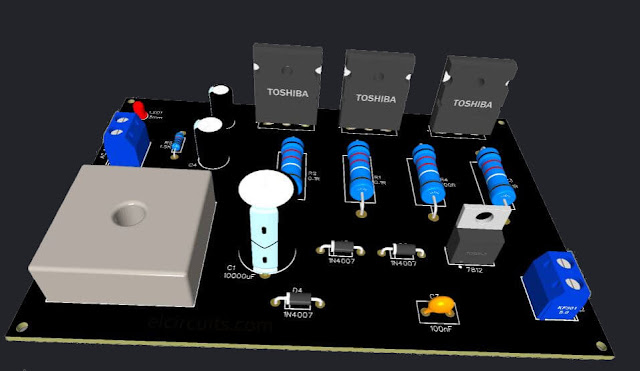 |
| Fig 1 - Hi-Fi 32W Audio Amplifier PCB |
- High Output Power
- 50W Music Power IEC 268.3 Rules
- High Operating Supply Voltage - 50V
- Single or Split Supply Operations
- Very Low Distortion
- Short Circuit Protection - OUT to GND
- Thermal Shutdown
You might also be interested in:
- 170W AB Class Bridge Mode Amplifier using TDA7294 IC + PCB
- High Fidelity 14W - 12V Power Amplifier using TDA2030 IC + PCB
- 24W Stereo Hi-Fi Audio Amplifier using TDA2616 + PCB
- 4 x 50W High Power Amplifier, 14.4V - IC TDA7563A + PCB
- 70W Stereo HI-FI Power Amplifier - High Fidelity with two TDA2050 + PCB
- 56W RMS Hi-FI Amplifier with LM3875 Integrated Circuit + PCB
- HI-FI 30W Audio Power Amplifier With IC LM1875 + PCB
- 5W BTL Audio Amplifier with DC volume control + PCB
- HI FI 32W Audio Amplifier - TDA2050 - Simple PS + PCB
- 180W RMS 4-Channel Amplifier with TDA7386 + PCB
- 100W RMS Audio Amplifier IC TDA7294 + PCB
- 170W AB Class Bridge Mode Amplifier using TDA7294 IC + PCB
- High Fidelity 14W - 12V Power Amplifier using TDA2030 IC + PCB
- 24W Stereo Hi-Fi Audio Amplifier using TDA2616 + PCB
- 4 x 50W High Power Amplifier, 14.4V - IC TDA7563A + PCB
- 70W Stereo HI-FI Power Amplifier - High Fidelity with two TDA2050 + PCB
- 56W RMS Hi-FI Amplifier with LM3875 Integrated Circuit + PCB
- HI-FI 30W Audio Power Amplifier With IC LM1875 + PCB
- 5W BTL Audio Amplifier with DC volume control + PCB
- HI FI 32W Audio Amplifier - TDA2050 - Simple PS + PCB
- 180W RMS 4-Channel Amplifier with TDA7386 + PCB
- 100W RMS Audio Amplifier IC TDA7294 + PCB
Description
The TDA 2050 is a monolithic integrated circuit intended for use as an audio class AB audio amplifier. Thanks to its high power capability the TDA2050 is able to provide up to 35W true RMS power how showed below:
- Into 4 ohm load @ THD = 10%, VS = ±18V, f = 1KHz up to 35W
- Into 8 ohm load @ THD = 10%, VS = ±22V, f = 1KHz up to 32W
- Into 4 ohm load over 1 sec at VS= 22.5V, f = 1KHz up to 50W
The high power and very low harmonic and crossover distortion THD = 0.05% typ, @ VS = ±22V, PO = 0.1 to 15W, RL=8ohm, f = 100Hz to 15KHz) make the device most suitable for both HiFi and high class TV sets.
The schematic diagram is shown in Figure 2 below, it is a simple circuit to assemble, and to use it in Stereo, we can assemble two of the same, one for each channel.
 |
| Fig. 2 - Schematic diagram Hi Fi 32W Audio Amplifier - TDA2050 |
Components List
The recommended values of the external components are those shown below. Different values can be used, however, to better performance, you must use these values.
Parts List
- U1 ............................ Integrated Circuit TDA2050 Audio Power Amplifier
- R1, R2, R3, R5 ........ 22KΩ 1/4w Resistor
- R4 ............................ 680Ω 1/4w Resistor
- R6 ............................ 2.2Ω 1/4w Resistor
- C1 ............................ 2.2uF /25V Electrolytic capacitor
- C2 ............................ 100uF /25V Electrolytic capacitor
- C3, C7 ..................... 1000uF /50V Electrolytic capacitor
- C4 ............................ 22uF /25V Electrolytic capacitor
- C5 ............................ 100nF Polyester Capacitor
- C6 ............................. 0.47uF Polyester Capacitor
- RP1 .......................... 47KΩ Potentiometer
- P1, P2, P3 ................ Screw Terminal Block: 2-Pin, 5 mm
- Miscellaneous .......... Heatsink, screw, solder, etc.
Printed Circuit Board
We're providing the Printed Circuit Board, we leave the GERBER, PDF, LAYOUT files, to be downloaded at the link below.
Downloadable files
Files: Gerber, Layout in PDF, PNG, for download. Direct link: Click Here!
If you have any questions, suggestions or corrections, please leave them in the comments and we will answer them soon.
Subscribe to our blog!!! Click here - elcircuits.com!!!
My Best Regards!!!
























